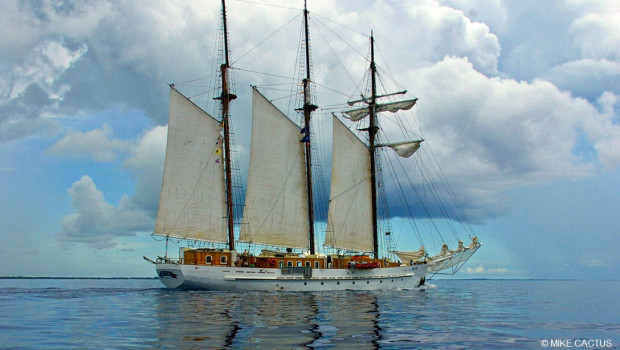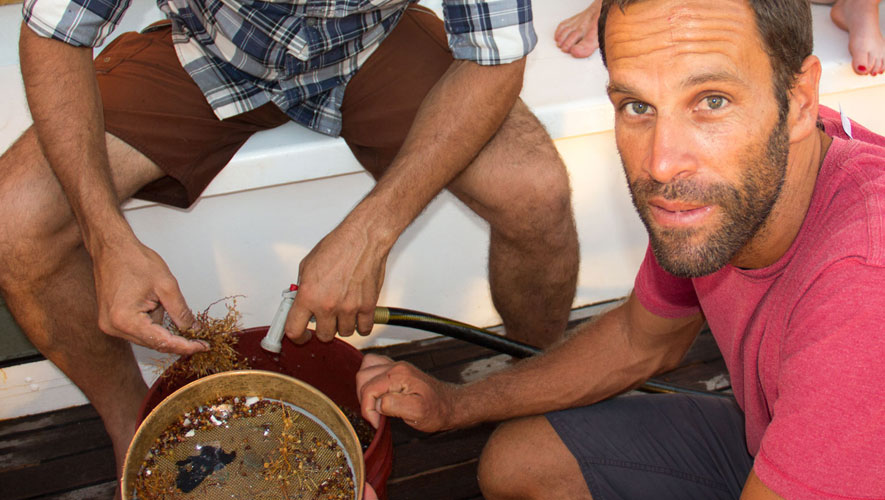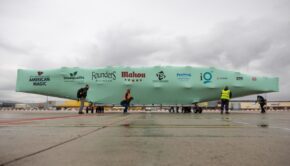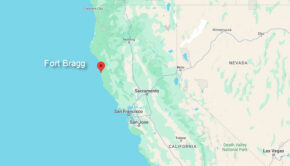Sailing through the Plastic Smog
Published on August 20th, 2015
The Mystic, a 167-foot-long schooner, bobbed as expedition leader Marcus Eriksen crouched over a trawl with Lindsey Jurca, of the Surfrider Foundation. Splayed on the deck, the trawl, with its steel-framed mouth and white-mesh body, looked like a strange fish. For an hour it had been skimming the North Atlantic Ocean, and in its tail was the data it had to share.
Jurca pulled seaweed from the net, revealing a colorful mass of microplastic clinging to the trawl. She handed it to Kristal Ambrose, of the Bahamas Plastic Movement, who hosed it into a sieve that her crewmate, singer-songwriter and ocean advocate Jack Johnson, held over a bucket to capture the shards, most smaller than grains of rice.
“An hour of trawling in some of the bluest water I’ve ever seen, and look at that,” Johnson said, peering into the sieve. The Oahu resident surfs around the world, wherever he’s on tour. Like others on this voyage – the surfer-environmentalist Jurca, surfing filmmakers Keith and Dan Malloy – he’s seen the planet’s most pristine oceans. Halfway between the Bahamas and the next port of call, Bermuda, this patch of the Atlantic was among the finest.
“The concentration must be increasing,” Eriksen reasoned. The team grabbed seaweed and teased out microplastic — 409 pieces in this batch alone, an average of 29,374 particles per square kilometer — occasionally pausing to reflect on the mirage of purity that extended in every direction.
That dichotomy — stunning views, hidden truths — would define this trip planned by Eriksen’s group, 5 Gyres. The nonprofit works to stem the tide of single-use plastics, which often get washed out to sea. For six days, the team conducted surveys within the North Atlantic Gyre, one of five huge circular currents in the sea. They found that even the bluest water is infested with what Eriksen calls “plastic smog”: pieces the size of zooplankton, which ride currents and end up ingested by sea life.
“The plastics start in our cities and flow downstream,” explained Eriksen. “The gyres are downstream from everywhere, so it all flows here. This is where it breaks down, thanks to wind and waves, sun and wildlife. As it degrades, it sinks to depth currents where it gets distributed worldwide. It’s everywhere.”
The Catch: Useful Data
In 2013, according to the EPA, the United States alone produced 33 million tons of plastic waste. Two types make up most of the plastic found at sea: polyethylene, used for bags and bottles; and polypropylene, the stuff of bottle caps, drinking straws, and fishing nets. Marine mammals get entangled in lost line, and particles have been found in creatures ranging from baleen whales that filter water to lugworms that feed on sediment, all because the stuff acts like plankton.
What this means for humans is unclear, but plastics are known to absorb pollutants. “Marine life pulls those chemicals off and stores them,” said Eriksen, “and they likely bio-accumulate up to apex predators” — including fish we like to eat: tuna, swordfish. “In rats, you see increases in cancers, obesity, and autism when you give them the kind of pollutants stuck to plastic at sea.”
Eriksen once worked for Charles Moore, who discovered the so-called Great Pacific Garbage Patch. The press ran with the story, depicting a dump the size of Texas swirling in the Pacific. In 2005, Eriksen sailed there with Moore and saw, not an island of trash, but a smog of microplastics. The garbage-patch myth was a blessing and a curse. It harnessed awareness but gave the impression that the pieces of garbage were big enough to remove, which is where most funding went—toward cleanup projects that didn’t pan out.
Last year, Eriksen published the first comprehensive global analysis of marine plastic pollution, and the results were frightening: The oceans are infested with 5.25 trillion particles weighing a collective 269,000 tons, distributed throughout the water column. Microplastic has been found in deep-sea sediment and Arctic ice. Like all 5 Gyres endeavors, this voyage was as much about distributing data as it was about collecting it—“to give thought leaders the information,” according to Eriksen, “so they can go forward it and give people a reality check.”
Among those along for the ride were Jeroen Dagevos, of Plastic Soup Foundation, a force behind antimicrobead campaigns; and Matt Prindiville, of Upstream, which advocates for laws that hold companies accountable for their packaging waste. Johnson had brought a film crew for a documentary about marine plastics, because, as he said, “it’s something that people can do something about. You can cut single-use plastics out of your life.”
But, as Johnson knows, it’s not just a matter of consumer choice. Before the Mystic had shoved off, the subject was discussed at a 5 Gyres–sponsored youth summit in the Bahamas. There Jamaican activist Lauren Silvera, 18, addressed the elephant in the room. “It’s not just a pollution issue,” she said, “it’s a poverty issue.” She described how Jamaican vendors sell plastic bags filled with fresh juice. If the bags were banned, how would the hawkers survive?
Eriksen understands the role poverty plays. He’s spent days with waste pickers in India, watching them collect reusable Coke bottles and ignore the cheap packaging used for goods sold to destitute families in the slums. He’s seen those flimsy packages blanketing streams before monsoons wash them out into the Bay of Bengal.
Port Of Call: Bermuda
Though these stark economics present challenges, Eriksen has witnessed victories. A number of American cities and the state of Hawaii have banned plastic bags, and so have dozens of countries, including ones with high rates of poverty: Bangladesh, Cameroon, Rwanda, and Tanzania. But it will take more. In the U.S., a dozen or so companies own the majority of consumer brands, including most organics, and unless they change the way they package products, the plastic flood will continue.
“It’s going to take a cultural fix,” Eriksen explained. “We extract materials, manufacture a product, distribute that product to consumers no matter what it’s made out of, and take no responsibility for what happens next. That kind of linear thinking has led to a massive influx of trash in the oceans. I’m hoping that this smog analogy will make people realize that if we create recycling economies, focus on prevention, and have producer responsibility dialed in, we can reduce the amount of waste.”
After sailing for nearly 1,000 miles, the Mystic docked in Bermuda, an island with little trash on its streets. But on its beaches, the crew picked through microplastics, including “nurdles”: pellets melted for products and packaging. They’re not made near Bermuda, but thanks to its placement in the gyre, that’s where they often land.
Still, Bermuda is gorgeous, and Eriksen and his mates found time to plunge into her turquoise waters. After all, it’s easier to fight for a healthy ocean once you’ve fallen in love with it, and from start to finish the North Atlantic had everyone inspired to spread the word about that big, beautiful sea and the plastic smog hiding in plain sight.
Source: Rodale’s Organic Life










 We’ll keep your information safe.
We’ll keep your information safe.